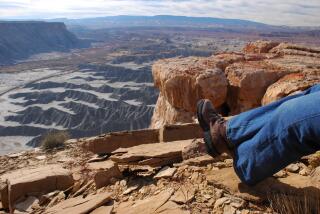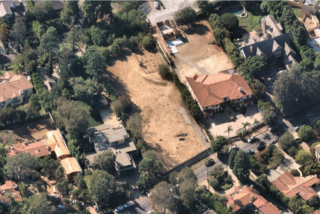Opinion: Habitat for all — how housing and biodiversity can coexist even in a crowded future

- Share via
Walking along the Colorado River behind the old factories on the east side of Austin, Texas, you might forget that you are in one of the fastest-growing cities in America. The riparian corridor below downtown is a rare zone of urban biodiversity. Herons and egrets fish the spillway. Owls, coyotes, hawks, deer and even ringtail cats thrive in the surrounding woods, within earshot of the tollway and the airport flight path. As Texas’ long hot summers cool into fall, the ospreys begin to arrive, and come winter there are bald eagles.
It’s reassuring to witness so much wild nature inside a major city. But it also fills you with a sense of anticipatory loss, if you know how threatened it is by development pressure — from the nearby pecan groves being cleared out to make room for new apartments and offices to the massive Tesla gigafactory recently built downriver. When the choice is between more housing and jobs for humans and space for other species, the humans always win. Maybe that’s as it should be. But what if it didn’t have to be a zero-sum game?
On a shrinking planet, habitat has become increasingly scarce for us and our nonhuman neighbors. In the U.S., affordable housing has escalated from a local problem to a major national one, as median prices have increased by nearly 50% since 2020, rising twice as fast as wages, and homelessness has reached record levels. Political leaders are talking about opening public lands for new housing. Less airtime is given to the stark tally of the biodiversity crisis: The World Wildlife Fund recently estimated that the wildlife population of the planet has plummeted 73% since 1970. The connections between these two crises are rarely examined.
The Ballona Wetlands Ecological Reserve, between Playa del Rey to the south and Marina del Rey and Venice Beach to the north, is a natural resource full of birds, small mammals and space to explore. Here’s how to help protect it.
Increasing the supply of human housing does not always deplete wildlife habitat. Indeed, the concentration of the human population in urban areas is an important strategy to combat habitat loss. But the linkage between our own development and our devouring of the world is inescapable. The appetites of growing and ever-more affluent human populations drive an almost insatiable need to produce more food and essential commodities, and a powerful incentive to turn more undeveloped territory into cropland, pasture and timberland. The connection between urban consumption and habitat destruction seems evident in the hemispheric distribution of wildlife population loss — 39% in the U.S. and Canada, but an astonishing 95% in Latin America — when you know which way the supply chains go.
Our capacity for myopia when it comes to the trade-offs between our lives and nonhuman life is profound. It’s embedded in language, in the way we refer to undeveloped lands as “empty,” “vacant” or even “waste.” It’s also baked into our legal and economic systems, which have few tools to value nature except as something humans own or consume. In part this reflects the more abundant world we evolved in, as bipedal hunters and foragers who walked out of Africa. That history of seemingly unlimited resources, made even more abundant through our control of fire and the reproduction of the plants and animals that feed us, has allowed us to ignore how reliant we are for our health and prosperity on the natural ecology that surrounds us. Living our lives in cities segregated from nature doesn’t help.
The largest wetland restoration effort in California has been slowly taking root along a stretch of San Francisco Bay that most people have never heard of.
There are signs we are developing new ways to recognize and address this dangerous imbalance. The emerging field of ecosystem services looks at the contributions of wild nature to human welfare through an economic prism, showing how, for example, the loss of predators, such as wolves, and scavengers, such as vultures, can be directly tied to a corresponding loss of human life and property those animals would have prevented by depleting the population of deer and cattle that might otherwise meet their deaths in automobile accidents or spread disease from their uneaten carcasses.
General awareness of the biodiversity crisis is spreading, in part through the changes we can see around us, especially those of us who have lived long enough to wonder why there are so many fewer bugs in the summer than when we were kids. And in some corners, meaningful action is being taken to link biodiversity health with human development, for the benefit of both.
In early 2024, England rolled out its final rules implementing a national requirement that new development of significant size demonstrate, after completion of the project, a 10% net gain in biodiversity on the site or in off-site projects. That such an encumbrance on property rights could be imposed by the then-Conservative government may reflect a uniquely British yearning for the green country of memory, but it’s a promising indicator of the change that’s possible.
Melanie Winter has long advocated for change along the L.A. River. As she undergoes cancer treatment, she remains focused on healing L.A.’s relationship to water.
We have fragments of similar policy in this country, as with the U.S. Department of Agriculture’s wetlands programs, and many successful efforts to rewild blighted corners of our cities, from the Fresh Kills landfill in Staten Island to the Ballona Wetlands in West L.A. If we coupled our need for new housing with a genuine effort to share our habitat with other life, we would quickly see how much of the natural character of the land where we build could be restored through modest investments and simple strategies. Nature is good at healing itself, when we give it room to do so.
Here in Texas, as in much of the country, the erasure of native life is relatively recent. Agriculture and ranching really only arrived in the 1820s, and while 99% of the blackland prairie that once ran from Dallas to San Antonio has since gone under plow or pavement, every spring its remnants still pop up in the margins. Texas communities spar constantly over the need to make room for humans and the need to protect wild nature. After the pandemic lockdown’s “nature is healing” reawakening, cities like Austin began taking steps to harness economic growth as an engine for rewilding the future. The balance may still be off, as with green urban creeks canyoned by new luxury high-rises that pay for them, or the restored riparian zone tucked behind the monolithic Tesla plant, but it’s a promising start that gives us a glimpse of the more profound results mandated biodiversity goals like England’s could deliver.
On the global scale, projects like Munich’s restoration of the Isar River and Seoul’s daylighting of Cheongyecheon creek show the revitalizing potential of rewilding in the heart of great cities. By coupling the development with enhanced standards for its ecological impact, we can address the housing and biodiversity crises at the same time, providing habitat for all. And by experiencing the richness of life in more biodiverse environments ourselves, you can bet we would learn to be better stewards of our planetary future — and happier ones.
Christopher Brown is a novelist, a lawyer and the author of “A Natural History of Empty Lots: Field Notes from Urban Edgelands, Back Alleys, and Other Wild Places.”
More to Read
A cure for the common opinion
Get thought-provoking perspectives with our weekly newsletter.
You may occasionally receive promotional content from the Los Angeles Times.













